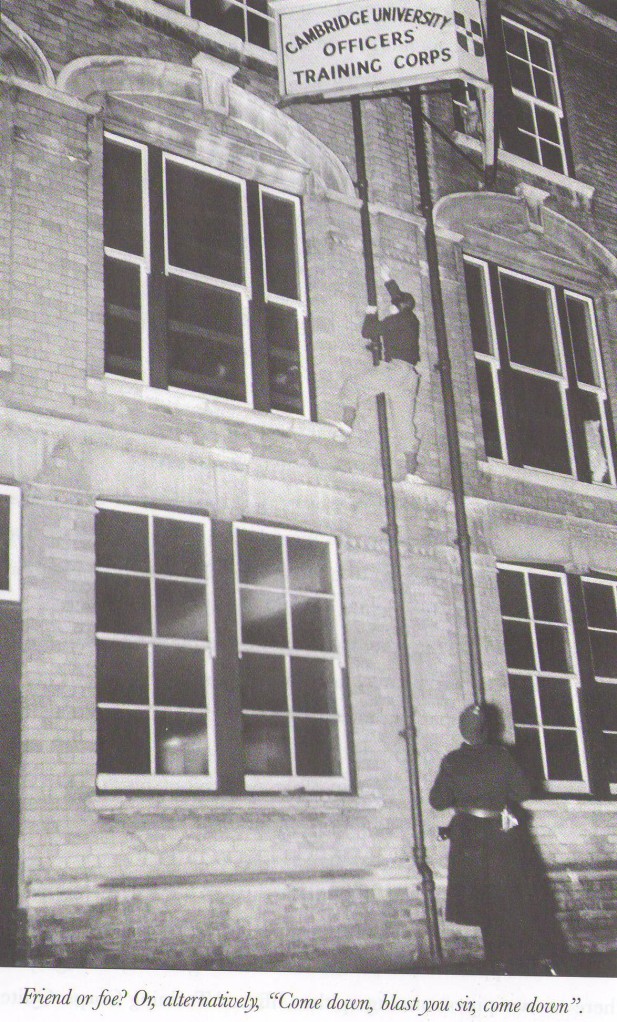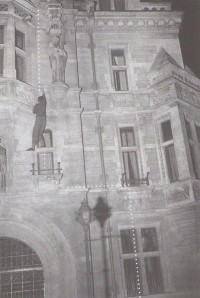Review: Night Climbers of Cambridge January 27, 2011
Author: Beach Combing | in : Contemporary , trackback[Note: Beachcombing apologises for any emails he’s not answered but the local internet provider has been down again for the last week: and he only has a couple of minutes with term beginning to rush in and put up posts at work. As soon as service returns he’ll be writing.]
Another classic from the vaults that has had, undeservedly, only a limited readership: the Night Climbers of Cambridge (1937). Written by one Whipplesnaith (pseudonym of Noel H. Symington) it recounts the adventures, in prose and photography, of a group of young Cambridge undergraduates who rather than study Norse, Latin and Sanskrit while down among the dreaming spires decided, instead, to climb said spires. The chapters begin prosaically enough with ‘Drainpipes’ and ‘Chimneys’ giving explanations and routes up some relatively easy Cambridge buildings. But from there they move on to more difficult edifices: Pembroke, Trinity, St John’s and, the legendary, in climbing terms, King’s College Chapel:
If this had been all then we would have a minor curiosity. There would be young men and marvelling crowds and applauding dons. But, of course, the activity of climbing was – for the student’s and the building’s safety – forbidden by the authorities. Hence the night climbers. The audacious undergraduates had to go out onto the heights after dark when (hopefully) no one would see them. They had to lug the heavy photography equipment of the epoch behind them. And then without rope (for the most part) they had to mug their way up various Gothic buildings without ropes or any other protection.
Now a taster from King’s College Chapel:
The clan gathered like earwigs round an orange-peel. The two Emmanuel men had dropped out, but the four remaining men trooped up to the roof at the first opportunity. All is not orange-peel that glistens, however. After they had groped their way up the spiral staircase [the door to which was opened after a visit to a criminal locksmith in London!] in single file, they stepped out on to the roof and proceeded to the far end. Here Hugh, of Caius, was called into action. He was at the time reputed, in a vague and shadowy way, to be the best rock-climber in Cambridge. The happy idea was that Hugh should climb up and lower a rope to the less elegant members of the party [rope is not for purists]. Hugh started up, and everyone was pleasantly thrilled. Everyone was confident of success. But at the first overhang he stopped. With five feet without a handhold, the overhang was more than he could manage. By a magnificent feat of balancing, he got his hand to within a foot of the next hand-hold above, but there he stopped. He came down again. If someone would come up with him so that he could stand on their shoulders – and he looked meaningly around…
The thrill of the book is the battle with two foes contemporaneously. The unforgiving buildings themselves: descriptions of nasty falls feature. But also the college authorities who chase the climbing tearaways from ledge to roof and then down the street. The stakes are high. If a climber is caught half way up a chapel or college wall then he will be sent down from university and cut off both from his degree and the buildings he so loves. Nevertheless there is a chivalrous affection for the human enemy.
One of the photographers, not himself a climber, fell off below the clock face and landed on his back on the slates. It was only a few feet, and he did not hurt himself, but he cracked some slates which had to be replaced. This cost the college three pounds [a lot of money in 1937]. The news reached us that the head porter attributed this to the clumsiness of the some builders some months previously. In pursuance of their no-damage policy, the photographers sent an anonymous letter with three pounds, entitled ‘conscience money’. The bursar must have been considerably surprised.
In the 1930s young Germans were spending their spare time duelling in the tradition of Bismarck: Beachcombing seems to remember that the Germany-maker took part in 22 separate duels as a youth? How marvellous then that their peers in Cambridge, instead of wasting their time with swords, were inventing new forms of idiocy on the cusp of the Second World War. Our Prussian duellers would soon be herding the ‘bandits’ of Eastern Europe out to pits in the woods or pointing their stukas at Belgrade and a dozen other cities. The Night Climbers, on the other hand, would be off to Bletchley to crack Axis codes or to the jungles of Burma, up onto the decks of destroyers and backwards and forwards across northern France in their bombers.
Now who says that a university education is a waste of time?
Beachcombing would be interested in any other night climbing books – he suspects though that this is the only one: drbeachcombing AT yahoo DOT com. He should also mention that this is no longer the rare book that it once was. It was republished by the Oleander Press in 2007 with excellent quality prints.
***
31 Jan 2011: Dan K emails to say night climbing is a pivotal plot device in science fiction writer Roger Zelazny’s 1976 novel, Doorways in the Sand. It inspired a similar bout of campus climbing during my own college days…’ Thanks Dan for this reference that had passed Beachcombing by! The plot seems to make it a pre-cursor to Hitchhiker’s Guide to the Galaxy?
13 Feb 2011: The legendary Mike Dash writes in (Beachcombing is not worthy) and notes: ‘Further to your post on the above topic, I note that you have omitted mention of the other classic text on the subject: ‘Hederatus,’ Cambridge Nightclimbing (1970). Luckily a full transcript of this rare volume was posted online a while ago and can be read here. The author of this post records the existence of a third volume, which I never seen: Trinity Roof Climbers’ Guide, by Geoffrey Winthrop Young. A friend of mine, who was a member of the CU Climbing Club, and who indulged this hobby while we were up (early 1980s), tells me – based I believe on lore handed down through the Club – that Hederatus was one of the two students responsible for hanging a “Peace in Vietnam” banner between the two easternmost turrets of King’s College Chapel. The same nightclimber was later caught red-handed while attempting the Senate House Leap, and was sent down.’ Thanks Mike!
30 April 2012: Forrest writes in: ‘I just read your book review of “Nightclimbers of Cambridge”, and did a little poking around and ran across the following webpage containing some more info on the topic of night climbing: It includes a transcript of the “Roof Climber’s Guide”. Thanks Forrest!





